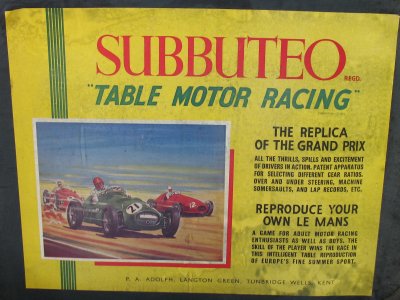
| Peter Upton's |
Subbuteo Tribute Website. |

A key part of the Subbuteo companion games of the 1950s and early 1960s were the racing editions. There were four versions; Speedway, Motor Racing, Horse Racing, and Cycle Speedway, but all four were essentially the same game. The only differences being small rule amendments to give each set a feel of the sport it was representing.
The various versions of the companion games catalogue that I've located only feature the Speedway version of the game and this does seem to be the most common version. However, I've also been sent details of a fantastic deluxe Motor Racing set.
This page would not have been possible without the help of Chris Boucher :-)
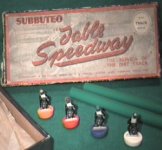
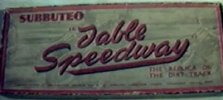

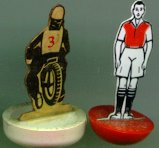
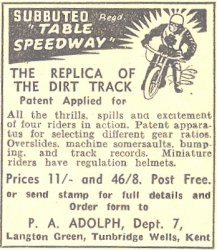
"The replica of the Dirt Track" was available as early as 1953, appearing in the Subbuteo Companion Sports Games catalogue of that year, and advertised in comics of the period. The advert here is from The Rover comic dated June 1953. I love "Miniature riders have regulation helmets" in this ad. That's a relief.
The game featured flat card or celluloid bikers on bases that look similar to the 1970s rugby bases in photos, but are in fact much bigger. Compare the biker with the Arsenal figure above to get an idea of the size. As usual, the bases have Subbuteo embossed around the outside edge. The sides of the base are steep, and the bottom is a smooth curve (oh err missus).
The advertising leaflet suggest that this game "introduces the most original and skilful form of propulsion ever", but then doesn't explain what this is. This perhaps is not surprising because how it worked was actually very simplistic. What you were given was a long plastic tube (green and red seem the favourite colours for these) and several sizes of ball bearing. You put the tube behind the rider and let your chosen ball roll down it so that it struck the rider thus propelling him around the track. The track was divided into sections 8 inches in length. The plastic tube stayed behind the start line of each section until the bike had completely left that part of the track. Once this happened the tube could be advanced to the start of the next area.
That's all there was to the basic idea, but to quote the advertising sheet again :- "The patented apparatus enables the reproduction of different gear ratios to be selected... Machine somersaults and overslides, Bumping, track records and lap dashes are all contained in the game... as in real Speedway - the rider who can follow the white line and gates successfully is generally the winner". Sounds like fun, and it is.... but certainly not as sophisticated as Peter Adolph's football game. One for the kids methinks.
There were two versions of this game available in the 1957 catalogue. As with the other Subbuteo sets of the 1950s, the smaller set contained a length of chalk to mark out your own board and keep the cost down.
| Standard Edition: | Cost 10/10 in 1957 |
| Standard Edition complete with Track | Cost 48/- in 1957. |
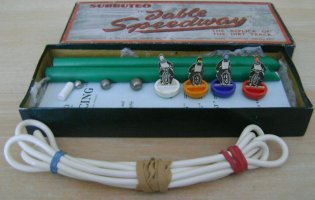
The assembly instructions included with the standard edition mention the following track-substitute, which seems to be frequently missing from sets -
The 72" length of white plastic tubing should be laid out in an oval and fixed to the chosen surface with 1.5" strips of adhesive tape, which should be torn off from the transparent envelope supplied, and can easily be removed without damage to the table. This is the inside "white line" and as the track measures 6" across, a line should be chalked around the outside of the track following the shape of the inner one. Small books should then be placed around the outer line to form a safety fence.
The track is divided up into nine movement sections, each section measuring 8" around the inside white line. These should be chalked out from the start and finish lime as depicted in the photograph. Remember that the speedway riders start in an anti-clockwise direction."
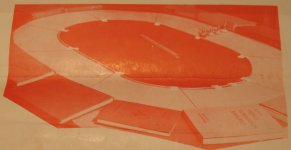
The back of the set-up instructions has this great picture, where you can see the tape (happily interfering with the inside lane), and the "book" safety fence, which is the sort of thing I used to do to stop losing the Subbuteo football, but I can't believe a game ever recommended it. The book nearest the camera is the thrilling "French Composition Simplified". No Subbuteo collection is complete without it.
The assembly instructions also mention that Speedway can be played on any shiny surface of approximately 48" x 36" in area. "Linoleum or a polished table being ideal surfaces". I'm sure mothers up-and-down the country were delighted when Speedway chalk marks were drawn all over their lovely polished dining room tables....
Like the football game of the time there were two sets of rules. A basic sheet for each game, and an advanced booklet that was designed to cover all four games. In reality, this advanced book was mostly speedway, with some good details on horse racing, but only a paragraph on "Motor and Cycle racing".
The advanced rules of Speedway were as follows (and they are not completely clear!)
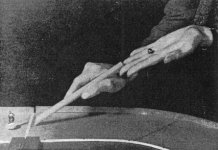
With Track Editions.
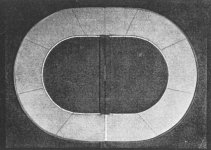
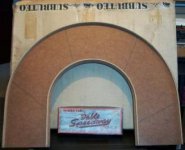
With the early versions of these sets the playing pieces still came in the small box, but this usually had a "with track" sticker on it. You can see an example of this on the box on the left at the top of this page. As the sets were sold mail order, the track only came in a big plain card box. The one illustrated here is sealed with Subbuteo packing tape, which confirms that it is the original box.
The track was advertised in the advanced rule book and it is believed that at least three versions were produced. 1950s collector Luca Genzano owns a copy of the hinged track shown above left. This was the track used in the rulebook pictures (as shown), and we are therefore assuming it was the first track to be sold. This track, with its large central hinge, is of all wood construction.
This means it is not the track seen in the early racing price lists which is described as being "manufactured in plastic and wood with calibrated Regulation lines, coloured green and white, hinged in the middle with extra shiny surface for the fast propulsion of the discs." The cost of this track was 37/11d (inc 6/11d p.tax). The colour picture above (taken from ebay many years ago) is possibly this second version - but it doesn't look coloured, or hinged.... so further work is required on this.
Later copies of the racing price list had a sticker over the old description, giving new details and stating that this "supersedes previously described... tracks and (is) available from 1/11/57". This final version was "special polystyrene plastic track calibrated with white regulation lines, sleeved in the middle to facilitate easy, quick assembly, with extra shiny surface for the fast propulsion of discs." Packed in attractive fitted box, this cost slightly less than the old track at 37/2d (inc 6/3 purchase tax) when introduced in 1957. This is the "mass market" plastic track that allowed Peter Adolph to produce a "proper" boxed track edition for the table motor racing game, which is dealt with below.
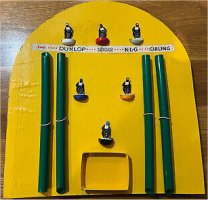
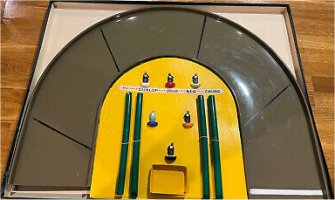
These final two pictures show the third and final version of the track in a more organised set that uses the box and cardboard inlay from the Motor Racing Edition (see below for comparison). The larger speedway set does not appear to gain a nice colour label even for this grand set. The box has a plain black lid adorned with the standard small box label stuck somewhere in the middle. It looks rather half-hearted for what is an attractive set once the box is opened (mind you, Subbuteo was mostly mail order at this time, so the outer box was not so important). It should be noted that because this set is using the motor racing layout, it has been provided with six bikes, rather than the usual four.
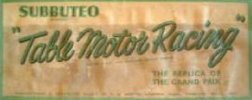
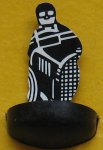

The above pictures show the small 1950s box, which matches the speedway one, and one celluloid motor racing "car". As you can see, this piece was the same cut out as the speedway bike and so there is only room for a small part of the car. In the motor racing set there were six cars, instead of the four bikes in speedway. Oddly though, the sets still only provide four chutes for the ball bearings, so someone will have to share.
March 2021: Ashley Hemmings kindly sent in a picture showing all the colours of the Table Motor Racing game - the green and black bases are the ones usually exclusive to motor racing.
With Track Edition.
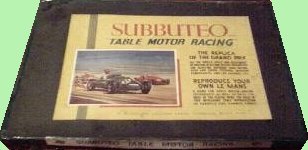
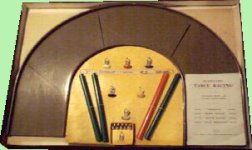
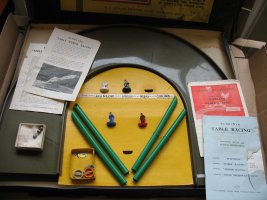
This fantastic set is a late edition with the final version of the track and a great display of the playing pieces. "Reproduce your own Le Mans" the label tells us, and it really makes me want to go out and do it (although possibly not for the whole 24 hours...) The choice of light green for the label just shouts "Subbuteo" and seems to tie this set to the football versions of the 1960s.
Feb 2014: - I have included a second photograph of the interior of a second set, because it (hopefully) shows the shiny plastic track more clearly. Note that the paperwork includes basic rules, advanced rules, and a price list.
The rules were pretty similar to Speedway, with the main differences being:-

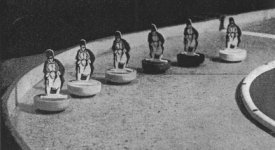
Once again Peter Adolph printed a different picture onto a speedway figure. This gave a rather odd look to the jockey who appears (in this photo at least) to be wearing a big hat and coat. And the poor horse is a bit short in the leg department.
Like motor racing, the game could be played by up to six players, and again there were some interesting changes to the rules:-
The advanced rule book went on to suggest an "interesting variant", which was Steeple chasing.

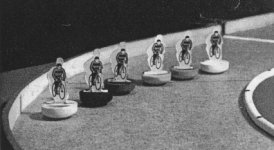
The advanced rule book does not have anything further to add about cycle speedway, save to refer back to the horse racing rules and "With a little imagination you can improvise on these for Cycle Racing, with your requirements, and it is quite possible to stage the famous French Tour de France" (as opposed to any other country's Tour de France then?)
Frankly, the mountain legs of the Tour de France are going to be a challenge.
February 2014:- Thanks to Ashley Hemmings for the colour photograph of the cyclist.
Accessory Range.
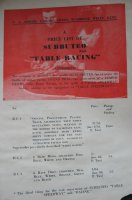
Like all Subbuteo games, Peter Adolph sold the components separately as an accessory range, allowing owners to replace parts, or add further figures. The list only had eight references, with the most notable being the production of celluloid speedway riders. The references were prefixed RC, which differentiated them from the cricket, which had no prefix, and the football list, which used letters.
| Ref No | Description | Price | Notes. |
| RC1 | Special wooden and plastic track calibrated with regulation lines, coloured green and white, hinged in the middle with extra shiny surface for the fast propulsion of discs. | 37/11d | Free postage! |
| RC1 | *Special polystyrene plastic track calibrated with white regulation lines, sleeved in the middle to facilitate easy, quick assembly with extra shiny surface for the fast propulsion of discs. Packed in attractive fitted box. | 37/2d | Note this is the second edition of the track. Sadly, the price list does not appear to be dated. |
| RC2 | Four base discs coloured red, blue white and orange. | 2/- | For speedway |
| RC3 | Six base discs coloured red, blue, white, orange, green and black. | For the six figure sports. Guess which colours are rare! | |
| RC4 | 2 press-out sheets depicting either -
|
1/3d | All accessories were 3d postage except the track and the rules. |
| RC5 | Advanced rule leaflet explaining how to play Horse, Motor and Cycling racing according to the number of persons playing | 9d | |
| RC6 | Set of four large type ball bearings | 1/3d | |
| RC7 | Two chutes | 1/3d | These were produced in red and green. |
| RC8 | Four celluloid speedway riders. | 1/10d | |
| RC9 | Six celluloid motor racing riders | 2/9d | This was added to later lists. |
So that's it for the racing games. They did not last beyond the early 1960s, and that must really be down to the wonders of slot car racing, Scalectrix and the like, which convey the speed and skill of motor sports in a way that rolling ball-bearings did not.
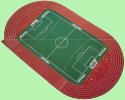 A final
thought is that this page might inspire those who have bought the huge Zëugo
racetrack for their Subbuteo stadium, and don't know what to do with it. I
suggest rummaging around in the garage, until you find a couple of ball
bearings and some tubing. Then grab a few Subbuteo players and have an
athletics meet.....
A final
thought is that this page might inspire those who have bought the huge Zëugo
racetrack for their Subbuteo stadium, and don't know what to do with it. I
suggest rummaging around in the garage, until you find a couple of ball
bearings and some tubing. Then grab a few Subbuteo players and have an
athletics meet.....
[ Main Page ]